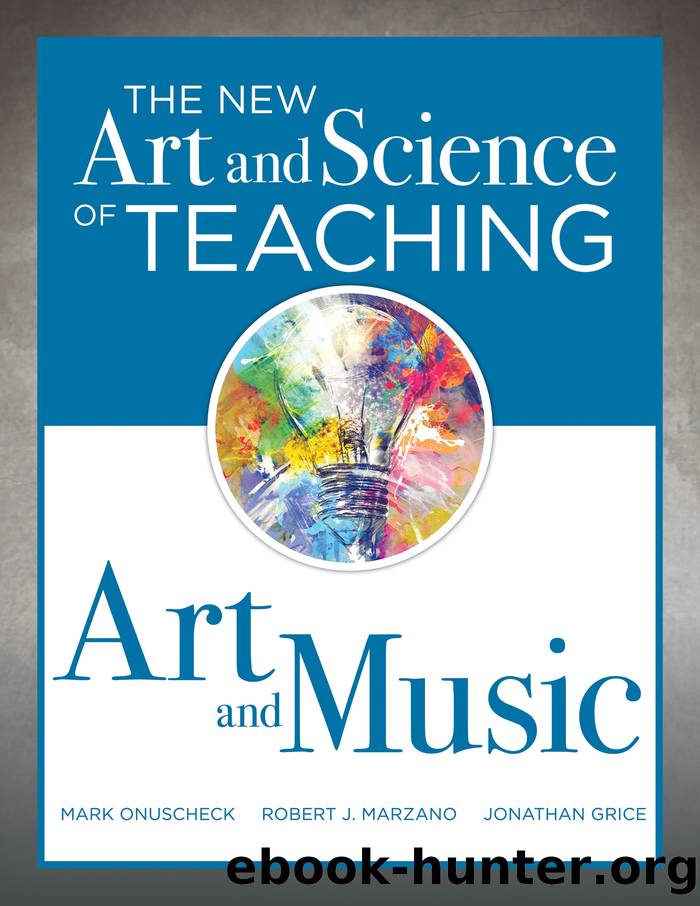The New Art and Science of Teaching Art and Music by unknow

Author:unknow
Language: eng
Format: epub
Tags: education, General
ISBN: 9781945349812
Google: cKU9zQEACAAJ
Publisher: Solution Tree Press
Published: 2019-08-14T23:21:05.016952+00:00
Figure 6.8: Self-rating scale for element 22âOrganizing students to interact.
Art
Since the creation of art is often a solitary and private experience, interacting in the art classroom must also involve building an environment of trust and productive connectivity. Often, students can be shy about sharing their work or discussing their artistic ideas. As you think about the following strategies for organizing students to interact, be mindful of how students can connect both thoughtfully and positively during the classroom experience. Establish norms for interacting and structure experiences that demonstrate nurturing interactions in the art classroom.
⢠Tables or pods: The teacher arranges the classroom so students sit in small groups at tables or clusters of desks. Having students sit in pods facing one another allows for easy interaction throughout the class period.
⢠Thoughtful seating charts: Based on preassessment data or observations, the teacher can use the achievement-ranked list method to identify the students that scored high, medium, and low on the performances. The teacher then uses the list to select mixed pairings or teams to support cooperative learning, such as peer-to-peer modeling, discussions, and classroom activities (Kagan & Kagan, 2009). The teacher should consider rearranging the seating chart after units or grading terms are complete to further reinforce the importance of interacting with others in the class.
⢠Student demonstrations: The teacher asks advanced students to demonstrate their artistic skills to the class or to less advanced classrooms. The teacher requires other students to write down questions to ask following the demonstration to foster student-to-student dialogue.
⢠Discussion protocols: The teacher establishes discussion structures and guidelines to help students talk to one another about their art. The teacher may assign roles and a specific protocol or format, or he or she might provide more general guidelines. With time and practice, students become familiar with these practices and student interactions become a natural part of the day-to-day culture of the art classroom.
⢠One-to-one technology: Laptops, tablets, and mobile devices allow students the flexibility to turn and talk to their neighbors, while also showcasing content on the device screens.
⢠Online interactions: The teacher guides students to use the internet to interact with one another and offer feedback. Students may post artwork and artist statements on the learning management system or class website. Peers then have the opportunity to post written messages or video responses to the work.
Music
Organizing students to interact in the music classroom has a number of interesting implications for the classroom dynamic. It can encourage higher levels of musical independence when students leave the safety of their section and stand next to students who play different parts, for example. Interacting can also promote a higher level of ensemble work, unity, and coherence during the classroom music experience. These suggestions help to engender partnerships in learning and nurture ensemble work.
⢠Tables or pods: In the general music classroom, students sit in small groups at tables or in clusters of desks. Having students sit in pods facing one another allows for easy interaction throughout the class period.
⢠Stand partners: In a large instrumental ensemble, the teacher pairs students to share a music stand.
Download
This site does not store any files on its server. We only index and link to content provided by other sites. Please contact the content providers to delete copyright contents if any and email us, we'll remove relevant links or contents immediately.
Kathy Andrews Collection by Kathy Andrews(11342)
The remains of the day by Kazuo Ishiguro(8415)
Paper Towns by Green John(4811)
Spare by Prince Harry The Duke of Sussex(4804)
Industrial Automation from Scratch: A hands-on guide to using sensors, actuators, PLCs, HMIs, and SCADA to automate industrial processes by Olushola Akande(4630)
The Body: A Guide for Occupants by Bill Bryson(4595)
Machine Learning at Scale with H2O by Gregory Keys | David Whiting(3660)
Be in a Treehouse by Pete Nelson(3654)
Harry Potter and the Goblet Of Fire by J.K. Rowling(3619)
Never by Ken Follett(3549)
Goodbye Paradise(3460)
The Remains of the Day by Kazuo Ishiguro(3148)
Into Thin Air by Jon Krakauer(3135)
The Cellar by Natasha Preston(3079)
The Genius of Japanese Carpentry by Azby Brown(3044)
Fairy Tale by Stephen King(2971)
120 Days of Sodom by Marquis de Sade(2947)
Drawing Shortcuts: Developing Quick Drawing Skills Using Today's Technology by Leggitt Jim(2943)
The Man Who Died Twice by Richard Osman(2823)
